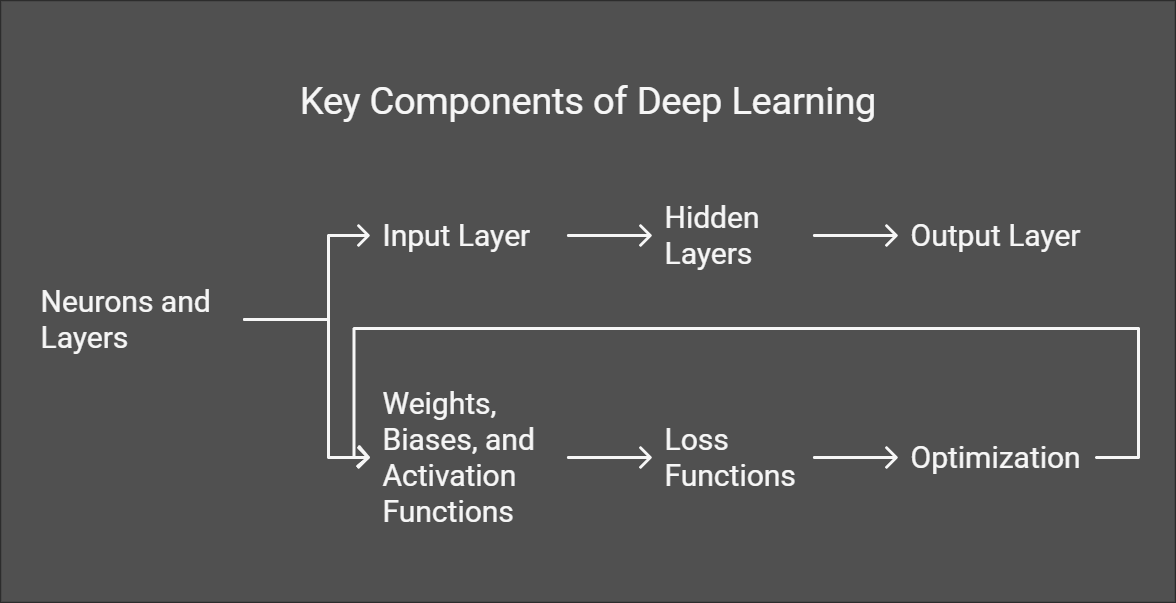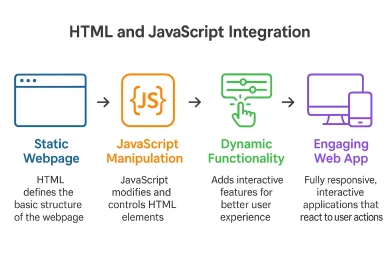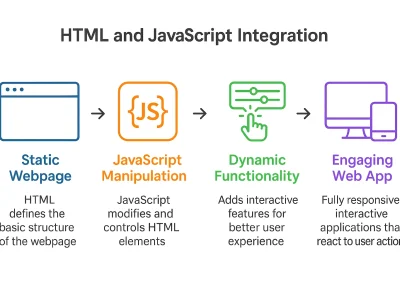Introduction
Deep learning has mentored modern and wallpaper industries within the bounds of artificial intelligence (AI) and even machine learning (ML). This is possibly because it conceives of the brain as more like a human; anyhow, it will revolutionize everything from self-driving cars to medical diagnostics. This blog takes readers through an introduction to deep learning, its components, applications, and future impact.
How Deep Learning Works Like the Human Brain
Deep learning reflects on human functioning because biologically, it is understood to function that way. Synapses connect neurons in the brain, which then fuse into clusters that work to process information, make decisions, or recognize patterns.
Deep learning models are artificial neural networks that join neurons as if they were layers to work on information processing and predictions. Therefore, deep learning is stronger in assimilating solutions to many complex issues, such as image recognition, speech recognition, and trend predictions.
Purpose of This Blog
This blog aims to introduce you to deep learning through both its core principles and real-world applications. By the end, you will have the confidence to say you know just what deep learning is, and how it works in the present and into the future. Whether you are just beginning or have some knowledge about the subject, this guide has valuable information to offer about one of the most revolutionary life-changing technologies in the era.
Understanding Deep Learning: Its Role in AI and Machine Learning
Deep learning is a particular branch of machine learning, which is itself a subset of artificial intelligence. Traditional models of machine learning require humans to specify rules and features for analysis. In certain deep learning models, neural networks automatically learn from large datasets by processing input through multiple layers to extract increasingly abstract feature representations for making decisions, pattern recognition, language processing, etc.
One could also say that this learning provides a means of accessing deep learning features. Therefore, it does very well for unstructured data (images/speech/text), where deep learning seems to exceed conventional machine learning methods in computer vision and natural language processing.
Deep Learning vs. Machine Learning: Key Differences Explained
- Feature Engineering: In traditional machine learning, an expert manually selects features from the data. In deep learning, the model automatically extracts features because of its layered architecture.
- Data Requirements: Deep learning requires a great deal of data to work, but traditional machine learning can perform well on small datasets.
- Computational Power: Compared to traditional neural networks, deep learning networks are almost always highly resource-demanding and need the running and working of a very powerful system, such as GPU.
How Deep Learning Predicts Outcomes: A Step-by-Step Guide
Deep learning models run data through multi-layered artificial neural networks or so-called models of a kind. Each layer, however, is made of interconnected neurons, each of which deals with one pre-processing action for the feature of the considered data. The model adjusts for interlayer neuron weights while setting biases with respect to interlayer neurons to reduce prediction errors and upon ending training makes accurately seen predictions from previously unseen data.
Key Components of Deep Learning
To understand deep learning fully, one would have to talk about the integral parts of neural networks:
- Neurons and Layers: Neural networks consist of layers of neurons, which, in turn, are the basic elements for processing data. These include:
- Input Layer: The first layer that inputs the data.
- Hidden Layers: Those between the input and output layers, where the data processing and feature abstraction occurs.
- Output Layer: The last layer the result outputs into; whether it is for classification, prediction, or decision.
- Weights, Biases, and Activation Functions: The amount of influence one neuron has on another is determined by the weight assigned to each connection between the two neurons. Biases help add flexibility to the system by shifting the output across the model. Activation functions, on the other hand, determine when to activate a neuron depending on the input, adding additional non-linearity in favor of the complex patterns the model is intended to learn.
- Loss Functions and Optimization: A loss function is an algorithmic method of measuring how precisely and accurately a model’s predicted results will correlate with actual outcomes. The goal is to minimize this loss, which is achieved by adjusting the weights and biases using optimization algorithms like gradient descent.
How Does Deep Learning Work?
Forward Propagation and Back Propagation
The forward propagation moves the data into and through the input layer and hidden layers, after which it moves to the output layer, leaving predictions at the output. The predicted outcomes are compared with the actual results to calculate the error in backpropagation. The next step is to reduce the error by updating weights and biases with a network. This is kept going on to train until the right results are obtained concerning the model.
Training and Learning
A Deep Learning model would be trained when fed with huge labelled datasets like learning over periods, showing patterns in data. It does learn to discern within the input data in the process. So, the more data it gets, the better it masters the complex relationships among them.
Types of Neural Networks
The different types of Neural Networks have been designed to address various problems:
- Feedforward Neural Networking: It is the most incisive kind of Neural Networking and is generalized to all data types, as a matter of fact. This form of Neural Networking is mostly applicable in one-directional flow performance for classifying input-output.
- Convolutional Neural Networks: This is more popularly used in image and video processing. CNNs can detect“ features such as edges, and textures in images, making it ideal for usage in applications like object detection and facial recognition.
- Recurrent Neural Networks: An RNN is a kind of network that works on sequential data, for example, text or speech. An RNN considers the order of data points, which is important in tasks such as language modelling or speech recognition.
- Generative Adversarial Networks (GANs): These networks consist of two networks, a generator and a discriminator, which always work against each other during their imposing creation of an artificial image or video.
- Autoencoders: The compression profile and, possibly, anomaly detection can be performed with this. The essential elements of the compressed data are anchored within the autoencoders, and hence, the data can be compressed without the loss of essential content.
Applications of Deep Learning
Deep learning brings revolution within industries and improves our daily lives.
Some applications include:
- Computer Vision: These are deep-learning applications that power facial recognition and object detection. For example, deep learning brings into existence systems for “seeing” and understanding visual data security systems for medical imaging.
- NLP: Deep learning employs machine learning in the provision of sentiment analysis, and language translation, and for creating chatbots that give machines the ability to know and generate human language.
- Speech Recognition: Speech Recognition Deep Learning Systems, for example, Siri and Google Assisting, now depend on Deep Learning to process the spoken language and respond with more accurate results.
- Health: Deep learning in health is used to analyze medical images to detect disease, create drugs, and predict patient outcomes.
- Autonomous Cars: Deep learning services interpretation of box and object recognition for self-driving vehicles and real-time decision-making when driving.
Deep Learning Frameworks Available in the Market
There are just so many of those deep learning frameworks that have simplified or are simplifying the building and self-learning of models. Here are some of them:
- TensorFlow: Audio of Production for Research and as well as Production Types by Google. TensorFlow is apart from being highly open-source and very flexible, because of the use case it allows researchers to do.
- PyTorch: It’s because of simplicity and dynamic computation graphs.
- Keras: This is a high-level neural network API that is built on top of TensorFlow, which is very user-friendly and easy for beginners.
The Future of Deep Learning: Trends & Innovations to Watch
Deep learning is believed to have a very bright future ahead. Some of the trends observed are:
- Explainable AI (XAI): As the deep learning models evolve and become more complex, so is the growing demand for transparency and explanation. Hence, these are the reasons why explainable AI is being targeted.
- Advances in Hardware: Specialized hardware such as GPUs and TPUs accelerate deep learning by allowing faster training of the models with more complex applications.
- Federated Learning: This allows machine learning models to be trained on decentralized data sources while keeping all information private. This is especially important in areas like healthcare and finance.
- Multimodal AI: Deep learning models of the future will fuse different forms of data, like textual, visual, and auditory data, to construct AIs capable of performing a larger set of applications.
Conclusion
Deep learning completely revolutionizes all industries and redefines their approaches to technology. The model of deep learning represents the human brain in processing huge quantities of data for prediction and from decision-making to conclusions very precisely. There is a bright future ahead for deep learning applications as they expand from healthcare to automobiles. Like all technology, deep learning promises a future of more wonderous advancements in perhaps near years to come.
Ready to dive into the world of deep learning? Join our Data Science Course and start your journey today! Whether you’re just getting started or looking to enhance your skills, we have the resources you need.
Is this blog helpful? Don’t forget to share it with others or bookmark it for later!





